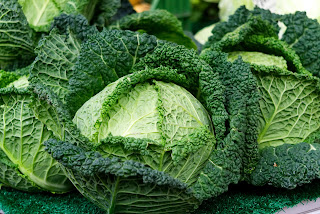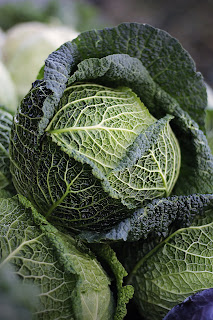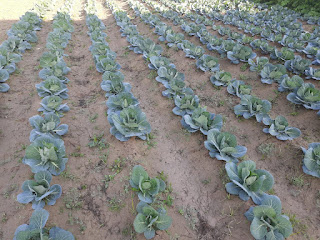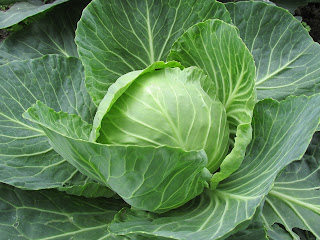horticulture guruji
Cabbage Cultivation
Cabbage (Brassica oleracea var capitata) is also known as ‘Patta gobhi’ in India. It is an important cole crop of the Brisicaceae family that needs a cool climate for proper growth. India (9.2MT) is the second-largest producer of cabbage in the world after China (34MT). Cabbage is a rich source of vitamin C which is necessary to avoid scurvy disease. It also helps in digestion. In this chapter, you will read its cultivation in detail.

Other Name:- Patta gobi (Hindi), Band Gobhi, Bandha Kapi, Karam Kall
Botanical Name:– Brassica oleracea var capitata
Family :- Crucifereae / Brassicaceae
Chromosome No.:- 2n=18
Origin :- Mediterranean region
Edible part:- Head (Enlarged and exaggerated terminal bud)
Fruit type :- Siliqua (a bicarpillary pod)
Important Point
- Cole Crops: -Cole word comes from “Caulis” meaning ‘stem’. Cole meaning a group of highly differentiated plants originated from a single wild cabbage (Brassica oleracea sylvestris).
- In the world India rank 2nd in cabbage production.
- In India from the total cultivated area under vegetable, cabbage contributes 4 % area.
- Aroma containing compound present in raw cabbage is Allyll isothiocyanate and in cooked cabbage Dimethyl disulphide.
- 30% area is covered by cabbage hybrid cultivars instead of other cultivars.
- Cabbage is a long-day plant.
- Cabbage is a cross-pollinated crop.
- Round-headed varieties mature earlier than the conical varieties.
- Sporophytic self-incompatibility present in cabbage
- Respiration rate of cabbage is low.
- A toxic compound sinigrin present in cabbage
- Savoy cabbage- Brassica oleracea var sabuda
- Wild cabbage – Brassica oleracea var sylvestris
- Hybrid varieties are developed using cytoplasmic genetic male sterility which is present in cabbage.
- Black Leg disease more if cultivated in saline soils.
- The temperate climate is suitable for cabbage seed production.
Watch Lecture Video




Area and Production (source NHB 2018)
|
Sr. No. |
States |
2018 |
|
|
Area (000 ha) |
Production (000MT) |
||
|
1 |
West Bengal |
79.46 |
2288.50 |
|
2 |
Bihar |
37.94 |
673.44 |
|
3 |
Orissa |
37.74 |
1058.78 |
|
4 |
Assam |
33.24 |
640.13 |
|
5 |
Madhya Pradesh |
29.89 |
686.91 |
|
6 |
Gujarat |
27.85 |
629.48 |
|
|
Other |
152.39 |
3060.10 |
|
|
Total |
398.51 |
9037.34 |
Economic Importance
- Indole-3-carbinol an anticancer compound present.
- Sauerkraut: – A processed product prepared from white cabbage and useful in scurvy.
- “Sauerkraut” is a German word meaning cabbage fermentation. Lactic acid bacteria play an important role in fermentation. They ferment leaf sugar and produce a distinctly sour taste product with a long shelf life.
- Cabbage contains 91.9 gm moisture, 1.8gm protein, 4.6 gm carbohydrates, 0.06mg thiamine, 0.03 mg riboflavin, 2000IU Vitamin A and 124mg Vitamin C per 100g edible portion.
- Cabbage has a cooling effect and helps in the prevention of constipation.
- It is speedup digestion, increases appetite and useful for diabetic patients.
Climate
Cabbage requires a cool and moist climate for its proper growth and production. In North India, it is cultivated during the winter season. Cabbage thrives well in frost as compare to cauliflower. Temperatures of 12–160 C are required at the time of seed germination. The plant growth stops when the temperature goes above 250C.
Soil
Cabbage can be cultivated in a variety of soils. Sandy loam soil is considered best for the early crop as well as clay loam or silt loam is preferred for the main crop. The average soil pH range of 5.5-6.5. If soil is acidic then add lime before sowing.
Varieties
- Introduction
Golden Acre
Red Acre
September:- from Germany, cultivated in Nilgiri hills.
Glory of Enkhuizen
Copenhagen market:- Early variety
August :- Early variety
Red Cabbage
2. Selection
Pride of India:- Round and early variety
Pusa Ageti: – Early variety, First tropical variety suitable for high-temperature conditions.
3. Hybrid
Pusa Drumhead:- Black leg resistant variety
Pusa Mukta:- Black rot-resistant variety
Pusa synthetic
Synthetic varieties: – When more than one inbreds with high GCA (General combining ability) are hybridized in all possible combinations and their seeds are mixed in equal amounts, it is called synthetic variety.
Pusa sambandh:- suitable for high density planting, early maturing, synthetic variety
Questo
Shree Ganesh Gol
Uttam
Bajrang
Green boy:- suitable for high temperature(30-350C)
Green Express:- suitable for high temperature
Green Challenger
Green Cornet
Savarna
Vishesh
Sudha
Ganga
Kaven
Yamuna
Hari Rani
Meenakshi
Stone Head
Nath Laxami 401
Beejo Sheetal 32
B.S.S.-32
N.L. 104
Sowing time
|
Varieties |
Seed Sowing time |
Transplanting time |
|
Early |
August |
September |
|
Main |
September |
October |
|
Late |
October |
November |
Seed Rate and Seed Treatment
About 375-500 g seeds are required to raise nursery for one hectare of land.
Before sowing seed is treated with 4-5 hours in plain water to enhance germination. Seeds are treated with Thiaram or Captan @2-3 gm/kg seeds before sowing to protect the crop from damping-off in the nursery bed.
Sowing
The seed is sown in raised nursery bed of 1.2m wide. Before sowing nursery, bed soil should be sterilized with formaldehyde. Generally, Seeds are broadcast on nursery bed. Then apply a thin layer of FYM or compost on the bed to cover the seeds. Immediately after sowing light irrigation given to the bed with a rose cane. Line sowing is not followed due to more incidence of damping-off in this method.
Field Preparation
Land should be plough 3-4 time and make soil tilth better. And at the last ploughing add 20-25 t /ha FYM.
Transplanting
The seedlings are ready to transplant 4-6 weeks after sowing. Planting of cabbage is done on the flat as well as on ridges. Ridges are more economical and commercially used. Ridges are made 60 cm apart and the seedling is planted at 45 cm spacing. After transplanting crop should be lightly irrigated.
Manure and fertilizers
The cabbage is a heavy feeder of nutrients. Generally, 20-25 tonne/ha FYM should be added to soil at the time of field preparation. In medium fertile soil require about 220 Kg N, 100 kg P and 220 Kg K. Full doses of Phosphorus, potash and a half dose of N should be applied at the time of sowing and a remaining dose of N is top-dressed 5-6 week after transplanting.
Irrigation
The cabbage is requiring a continuous supply of moisture in their entire life. The crop should be irrigated 10-12 days interval. When the head is beginning to develop continuously lightly irrigate the crop.
Weed Control
Weeding once done between the interval of two irrigation. Cabbage is shallow-rooted crop so hoeing is not beneficial in increasing yield. Therefore, some herbicides are used to control weed population like a pre-emergent spray of Oxyfluorfen @ 0.25Kg /ha one day before transplanting, Nitrofen @2 kg/ha or Alachlore @ 2 Kg/ha also effective.
Harvesting
When head attains full size and hard it is harvested. Generally, Early varieties ready for harvesting about 70-80 days and late 100-120 days from transplanting. A cabbage head is cut with a long knife or sickle. After harvesting, outer leaves are removed to giving a better appearance and convenience in handling.
Yield
The yield of cabbage varies on the season, variety and locality. An average yield of cabbage is 20 -50 tonnes/ha.
Insect Pest Management
- Cabbage and turnip aphid (Brevicoryne brassicae):- This insect is more serious during the late season of the crop when it is left for seed production. Insect suck sap from tender plant parts. Later wrinkled, downward-curling of leaves, yellowing of leaves, growth of the plant is reduced, contamination with aphid honeydew is seen on affected plants.
Control
- Spay the crop with Malathion or Parathion in seed production or early stage of plant growth, if the head is ready to harvest then nicotine sulphate is used to control.
- Dimmond Black Moth (Plutella xylostella):- This is a most damaging pest of cabbage. Larvae of the pest feed on foliar tissue except for leaf veins due to this photosynthesis process are checked and plant growth is stopped. The dropping of leaves is also starting.
Control
- Grow mustard with the crop as a trap crop
- Spray 4% Neem seed carnal oil.
3. Cabbage head borer or stem borer (Hellula undalis):- Caterpillar bore the stem, leaves and head. It makes cabbage unfit for consumptions.
Control
- Spray the crop with Fenvalerate 20 EC or Cypermethrin or Deltamethrin 28 EC 250 ml.
- Biological control using Microbracon mellus and Apanteles crocidolmiae.
Disease Management
- Damping off (Phythium Or Rhizoctonia sp. Or Fusarium sp.):- Damping-off is a nursery bed disease. In this disease collar region of the seedling start rot and seedling fall on nursery bed resulting death of the seedling.
Control
- Seed should be treated with thiaram or captan 3gm/kg seeds before sowing.
- Drench the soil of nursery bed around the seedling with captan 200 gm/100 litres of water twice.
- Before sowing seeds should be treated with hot water (500C) for 30 minutes.
- Nursery bed should be sterilized with formaldehyde before sowing.
- Downy mildew (Peronospora parasitica):- Initial symptoms are shown on the lower surface of the leaf as purplish-brown spots. Later stage dark sunken spots are seen on the stem.
Control
- Follow crop rotation.
- Kept field weed-free.
- Before sowing seeds should be treated with hot water (500C) for 30 minutes.
- Seed should be treated with thiaram or captan 3gm/kg seeds before sowing.
- Black leg or Black rot (Xanthomonas campestris):- The initial symptom is V-shaped yellow lesions on the edges of leaves which turn dark and brown later. Malformation of leaves, blacking of veins which are latterly dry up and die.
Control
- Seed should be healthy and taken from healthy plants.
- Before sowing seeds should be treated with hot water (500C) for 30 minutes.
- Seed should be treated with thiaram or captan 3gm/kg seeds before sowing.
- Spray the crop with 1 g of streptocycline.

